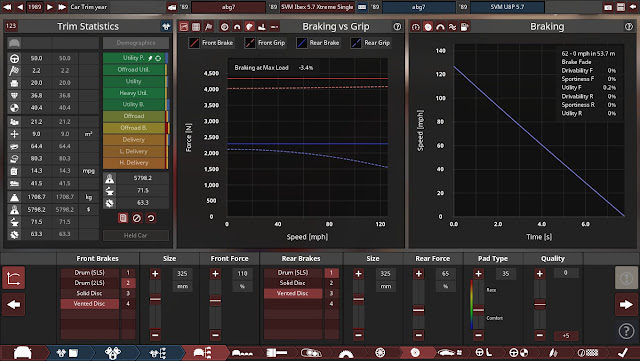Confessions of an Automationeer, Part 136: A Personal CEL Challenge
Having already created a build based on the results of a random combination generated by my CEL Challenge Remix spinner wheel set (and created several trims of it for good measure), I decided to revisit the original CEL Challenge set, with a twist: I would apply the regality rules from my CEL Challenge Remix. With this in mind, I generated a random combination of options and quirks, and after a few seconds, the CEL Challenge spinner ended up with this:
To my surprise and amazement, the CEL Challenge spinner wheel set suggested a 1980s Italian supercar - and this time there would be no Lucky or Unlucky quirks, thus giving me free rein to develop the build if I went through with it. With the criteria set, I started work on the build. Within an hour, I ended up with this:
This is what I built based on the suggestion from the CEL Challenge above. In its current form, it does not have a detailed interior, but I consider its exterior design to be mostly sorted out.
Engineering-wise, this is a purebred performance car, powered by a 4000cc all-aluminum V12 with dual overhead camshafts per bank and four valves per cylinder. With multi-point EFI (electronic fuel injection), fully forged internals, individual throttle bodies for each cylinder, a high-RPM performance intake, and long tubular exhaust headers feeding high-flow three-way catalytic converters (plus two reverse-flow mufflers), this small but light powerhouse delivers 400 horsepower at 7500 rpm (just 300 rpm before the rev limiter, which I set at 7800 rpm) and 283 foot-pounds of torque (at 7200 rpm) on 95 RON premium unleaded - a sizable amount for its variant year of 1982. All this thrust goes to the rear wheels via a five-speed manual gearbox and a geared limited-slip differential.
400 horsepower from 4.0 liters in 1982 is an amazing figure, especially with natural aspiration.
Given that I was building a high-performance mid-engined car, I needed genuine sports compound tires and a large amount of tire stagger - the rear tires, surrounding 16-inch forged magnesium wheels, are 285mm wide, whereas the front tires are 225mm wide. Braking is by large vented disc brakes (measuring 325mm wide front and rear) with 3-piston calipers. No undertray was fitted, but I installed a lip fixture at both the front and rear (the latter taking the form of a diffuser), as well as a rear wing to keep the tires planted. The interior is of the lightweight sports variety with a premium stereo and cassette tape player, and it incorporates advanced safety systems (for the 1980s), although no driving aids were fitted.
Steering is by an unassisted (manual) rack-and-pinion set-up to save weight and increase sportiness. The suspension is a dual-wishbone set up front and rear, configured primarily for razor-sharp handling through stiffened gas-mono-tube dampers and standard (i.e. non-progressive) springs. To avoid excess oversteer, I mounted the engine as far forward as possible (a necessity due to mid- and rear-engined cars having their mass too far aft in the 4.2 release of Automation). In addition, I set the weight slider to its lightest setting (which worked wonders given my choice of body set and use of aluminum panels over a corrosion-resistant steel chassis - the lightest materials available in 1982 with the tech pool allocation I used), thereby increasing sportiness even further - I managed a figure of over 60 with this build.
Surprisingly, I used only 30 fixtures to make the exterior, and yet the result turned out rather well. However, I have not created a fully detailed interior for this build, although I wasn't obliged to do so. If I choose to create a detailed interior after all, I could do so using only 20 fixtures at most. The result would, in theory, have no more than 50 fixtures in total - defying the belief that more fixtures is always better.
Here is what the interior for the car shown above could consist of if I were to abide by the 20-fixture limit for that part of its design:
- 7 fixtures for the basic interior structure (1 fixture each for the roof, front firewall, rear firewall, A-pillar, C-pillar, door cards, and floor pans, the last four of which are mirrored on both sides)
- 2 fixtures for seats and pedals (one of each)
- 2 fixtures for the center console (one each for the console itself and the gear shift lever)
- 4 fixtures for the dashboard (one for the main body of the dashboard, plus one each for a dash filler, an instrument panel, and a cassette tape player)
- 3 fixtures for the steering wheel and the wiper/indicator stalks attached to it
- 2 fixtures for the door handles and speakers (1 of each, both of which are mirrored on both sides)
Keeping these requirements in mind, a detailed interior requiring a low fixture count would be doable with the right fixture choices.
In short, this personal CEL Challenge (based on the original rules) proved quite enjoyable for me, and yielded a decent starting point for a fully detailed build if I were to go through with it.




















